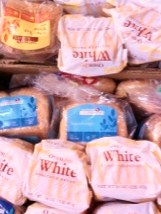Day 1- Counting the Loaves.
The Motherly Volunteer peered through the doorway and looked at the rain-sprinkled clients sitting patiently. Some had wired, wheeled carts to carry their boxes to the car, others relied on the ones provided by the Food Bank. Many had been waiting for an hour, drops still glistening on their parkas. The Motherly Volunteer counted the clients, many of whom she’d gotten to know at her five years volunteering at the Food Bank.
peered through the doorway and looked at the rain-sprinkled clients sitting patiently. Some had wired, wheeled carts to carry their boxes to the car, others relied on the ones provided by the Food Bank. Many had been waiting for an hour, drops still glistening on their parkas. The Motherly Volunteer counted the clients, many of whom she’d gotten to know at her five years volunteering at the Food Bank.
One man was particularly painful to look at. He was tall – towering over the shorter Chinese senior citizens who made up Wednesday’s gathering of lottery clients. They got a number, and that was the order in which their pre-made boxes of food were pulled from the back.
This client’s hair had grown shoulder-length. When he’d had a job it would have probably been shaved to his neck. His smile was a cross of “this is only temporary” to “I am really down and out.” He didn’t know which smile to wear, so it was a crooked, crossed line of “between”- did he conform to the rest of the crowd or pretend that he really didn’t belong?
Then, the Motherly Volunteer cocked her head to the left, and counted the loaves of folded, unsliced bread provided by the submarine sandwich shop across the street. Bags were taped crudely along the loaves’s torn seam so the bread didn’t get stale exposed to the air.
She heard the Food Bank program manager give the usual address, but this time with a caveat.
“Trader Joe’s isn’t here yet… the driver is late… so you’ll only be able to take one loaf of non-sliced bread home.”
The Motherly Volunteer recounted the clients. Thirteen. She recounted the loaves. 26. Or was it 25?
She peered closer to see if there was one more loaf, leaning as if she wanted to physically go over to the box. But something held her back, as if she didn’t want to call attention to herself scurrying through it and making the clients feel needier by having her inventory physically, like she was searching for one last morsel for them.
When the manager walked impatiently to the storage room at the Food Bank, as if her presence would make the Trader Joe’s delivery man appear any sooner, the Motherly Volunteer took her aside.
“The clients can still have two loaves of bread. I counted them.”
The Food Bank may be not be that much bigger than a portable classroom, but its reach to the hungry in this small East Bay city is huge. Two thousand families a year walk through the trailer doors, and it’s a bastion of goodwill for volunteers the moment they walk in and put aprons on to the moment they leave with a client often saying: “bless you.”
But it is also a structured system of giving commodities to the hungry in stations.
First, clients get their family boxes with mandatory staples. For example, a family of four will get 1 box of cereal, 2 pounds of pasta, 1 pound of rice, 4 servings of vegetables in cans, 4 servings of fruit in cans, 2 cans of beans (it could be chili too), a carton of eggs, and county-donated chicken parts for five days.
Then the clients can shop the Trader Joe’s line. Trader Joe’s is the gravy of the Food Bank, providing artisan bread, cheese, desserts, and exotic fresh produce. The bounty the Food Bank gets every day from Trader Joe’s has been overlooked by people who can afford to shop there every week. This manna from heaven is supposed to come to the clients every day before they arrive, but often – as today – they sit and wait.
The cautionary beep of a truck backing up sounds, signaling the Trader Joe’s delivery is here. Then the rush to get the goods out begins. Disorganized boxes are thrown on the ground with volunteers jumping to hastily sort and classify.
“I hate it when this happens,” said one volunteer said. “The rush.”
Yet the rush is altruistic adrenaline to me on my first day. Egg cartons tip out of boxes, packaged microgreens in flimsy plastic containers fall on their sides, pizzas wheel on the concrete floor.
“Eggs are the lowest priority,” the manager said as she saw me picking through cartons, tossing the invariably cracked ones into a bin. “Get the bread out first.”
The last stop for clients is the “Exchange Table,” where they can take a canned perishable good they don’t want from their family boxes and swap it for something they like better. Green beans for tuna was the swap before one client headed out to her car.